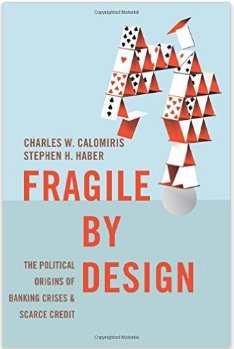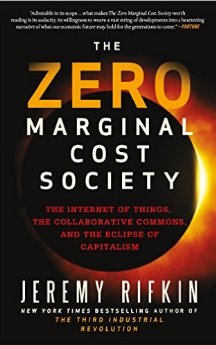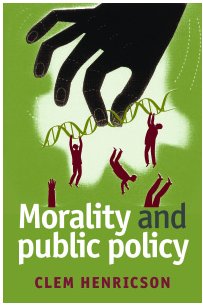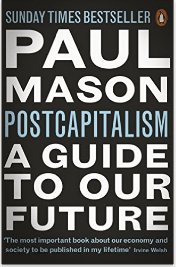
A new collation of non-fiction reads that, we hope, will both mirror and contribute to a range of contemporary issues. Find the social, political, economic and artistic.
A regularly updated list, you can securely buy the titles that interest with a single click, using your Amazon.co.uk account direct from our pages.
We are always happy to share your recommendations or new publications with the conversationsEAST readership. Keep us updated here.
Fragile by Design: The Political Origins of Banking Crises and Scarce Credit
Charles W. Calomiris and Stephen J. Haber
Princeton University Press, New Jersey, 2014

Canada has never had a banking crisis. The USA has had at least twelve economy wide crises since 1840. The authors of this book have examined the economic and political history of th UK, USA, Canada, Mexico and Brazil. Over the centuries in their view, it is a complex amalgam of politics, shareholder pressure, depositors and debtors to banks and the tax arrangements of all the key players that contribute to stability of banking systems.
The authors recognised a disjunction between the perception of banking by the polity, the way banking and banking affairs are portrayed in the media and how ordinary people, as economic actors, understand that there is a connection between banking and politics, but are unable to make an explanation of it lucid.
Calomiris and Haber set out to answer three short questions, namely…
1. ”Why are some societies able to construct banking systems that avoid banking crises, while others are not?
2. What makes some societies limit the right to charter a bank to a favoured few, even though doing so limits the the availability of credit to broad swaths of the population?
3. Why do societies sometimes fail to protect the property rights of lenders, depositors, and bank shareholders in ways that undermine the ability of banks to raise funds or lend them?”
If you have even a passing interest in your bank and the system that supports it, there are some wonderful insights to be had for the banking novice in this book.
‘Under-banking‘ is stressed by the authors as critically troubling. This is where the banking system of an economy provides too little credit in relation to the the size of the state commercial infrastructure.
Apart from the social cost of limited credit there are the ensuing issues that put the state’s ability to defend itself and to wield influence on the world stage. The authors have it that credit supply is is even more serious than a lack of capacity in the real economy, as it facilitates, or not when under-banked, all other sectors in a nation’s economy.
Worldwide, the literature quoted shows that the costs of underbanking are enormous.
‘Over the period 1970 to 2011, the median direct fiscal cost of banking crisis resolution was 6.8% of GDP and the median increase in country indebtedness during a crisis was 12.1% of GDP. The cost of banking crises in terms of lost GDP (due to the effects of credit contractions, heightened sovereign debt risk and currency collapse on economic activity) also tends to be enormous: from 1970 through 2009, the median lost output during a banking crisis amounted to 23% of GDP’.
Most ordinary people with a bank account will not have heard of ‘under-banking’ as a concept, we suspect, when listening to a procession of Chancelloric announcements about quantitative easing or ‘money creation’ exercises to ‘stimulate’ the economy.
Another important factoral change in the banking system is that, according to Calomiris and Haber, until the mid-Twentieth Century the costs of banking crises and failure were borne by the bankers themselves. Since that time the costs of failure have been transferred to the tax-payer.
As a banker, if I know the State will pick up my bill, I am happy to let the level of risk I take increase and the portion of my capital, kept in reserve, to diminish. We have all seen the resultant consequences. The state, having accepted this state of affairs, is now itself in conflict with the system.
Banks are expected to be a source of finance and be subject ot tight regulation. When government’s seek tight contractual control of debt to attempt a recovery from an exposed position, it is the enforcement of these strictures that looks to confiscate debtor assets, tax payer assets, in payment of the debts outstanding. The very people to whom government tacitly looks to provide the capital to close the circle and rebalance the banking books. As well as the votes to keep them in power.
This book, Fragile by Design, looks at other international debt crises in detail. It uses interesting analysis and case studies to examine how two countries, the USA and Canada solve, or otherwise, the murky relationship between the bank account holding polity, the banks and the state.
It also takes broad, detailed look at why states need banks and banks need states …whatever the current nature of an ongoing tortuous and costly relationship in 2016.
We commend the work of Calomiris and Haber to our readers.
![]() Buy this book with free delivery
Buy this book with free delivery

The Zero Marginal Cost Society
Jeremy Rifkin
Palgrave MacMillan, New York, 2015
This is a perceptive book that nicely captures some of the structural changes happening to markets in particular and the current assault on capitalism in general.

Rifkin presentss these disturbances in the capitalist ether as essentially a journey from the market place to a world of Collaborative Commons. He looks at how the Internet of Things, on-line education via MOOCs, new technologies and ‘maker’ enthusiasms and expertise are crumbling the walls of personal, private ownership and transforming the mechanisms of exchanging value between individuals.
It is a beguiling argument.Citing John Maynard Keynes from the 1930 publication, Economic Possibilities for our Grandchildren, he argues that even from the viewpoint of the third decade of the Twentieth Century, Keynes saw ‘…new technologies were advancing productivity and reducing the cost of goods and services at an unprecedented rate‘.
Although this might, in the short term, introduce the Keynesian notion of ‘technological unemployment’, these advances would, Keyne’s argued, eventually allow humanity to solve its ‘economic problem’. Rifkin argues that the time is now upon us.
In the most telling chapter in the book, The Comedy of the Commons, Rifkin cites the work of economist Elinor Ostrom, The Governing of the Commons. Ostrom found that management of commonly held assets, historically by consent and with full and appropriate dialogue in a community led, contrary to the expectations of self interest and greedy acquisition by mainstream economic thinkers, to the contradiction of the shibboleth ‘…that each individual seeks only his or her own immediate self interest in the market’.
The Commons philosophy and agreed constraints and punishments for Commons infringement create, Ostrom argued, very strong ‘social capital’. Rifkin counterpoints this advantage with the deleterious slide into private hands of much state infrastructure from the Thatcher era onwards. Achieved with little or no debate, and often, he argues as a result of disaffection in communities with government command and control processes.
However, now we see, in the real economy an acceptance of a more Commons approach to governance and practice. The old order is changing.
The emergence of social investment, the creation of social business, where social outcome supercedes profit but not to its entire exclusion. The Commons concept also drives and invigorates a multitude of services on the internet. From the most used, reader created encyclopedia to a whole raft of creative image resources for web design and gallery sharing. Even if imperfectly created in the pure Commons image, they define our lives now in way unimagined before the arrival of the www pre-fix.
Rifkin arges for the Commons as a management and governance device for diverse utilities and services. We thought reading the chapter, why is the Post Office not a social enterprise? Why is the railway system, built with finance created by the rise of capital in the Victorian period, not governed and owned by and for the benefit of the community of travellers who use it? Similarly with the National Health Service, the inevitable fall to the bottom of ‘the market’ for our health services, with all the inequalities that can bring could, just could, be halted by the introduction of Health Areas coagulated as Commons machinery.
We leave the last word to Jeremy Rifkin.
‘The new commoners make up far more than a political movement. They represent a deep social transformation whose impacts are likely to be significant and long lasting as those that catapulted society from a theological to an ideological worldview at the onset of the capitalist era‘.
The battle is entrained. Read this book and see why.
![]() Buy this book with free delivery
Buy this book with free delivery

Beyond Chutzpah – On the Misuse of Anti-Semitism and the Abuse of History
Norman G. Finkelstein
Verso Publisher, UK, 2005

Looking back through my recent RSA library reading list, this was perhaps the most difficult book I have read since visiting the stacks in the basements of John Adam Street.
Not because it is not erudite and well written. Not that the arguments are unclear or imprecise. Not that the academic research presented lacks detail. I found the book shocking in the way that only something surprising, un-announced and unexpected can be. The top layer of that surprise was electrified by the utter simplicity of Finkelstein’s core position.
I write this reflection from the assumption, long held, that the Palestine/Israel conflict is vastly complex in origin, and that the western critiques of that conflict, which I have previously taken at face value, do not need to be challenged. It is challenge that Finkelstein offers a-plenty.
Although my life has been contemporaneous with Finkelstein, if rather different, I have grown up holding empathetic consideration for both parties to the sruggle. As a humanist European baby-boomer, western educated, left leaning liberal thinker, I have no direct experience of the conflict in focus but have, in the past, expressed my sympathy for the humanitarian plight of both the Palestinians and the cataclysmic history of European Jewish people both within the context of my background and understanding.
Greater minds than mine have failed to resolve the conumdrum of the conflict. However, the Finkelstein opus does cut thorugh the political fog with some clarity and brevity, recognising that where you stand politically tempers perceptions of the efficacy of such excision.
The main three strands of Finkelstein’s thesis in his book are as follows.
The roots of the Palestinian crisis lie in a simple proposition, Finkelstein argues, long obscured by the conflict itself, the mythology of peoples in conflict and by the ‘misuse’ of anti-semitism to press an advantage for one side of the conflict equation. That proposition is that the Palestinians lay claim to their homeland and a distinct and separate nation, with all the rights that should afford them, from a secure position of ‘original ownership’.
The second mythological position is, Finkelstein argues against by way of example, that the Palestinian homeland, when taken over by the emergent Israeli State, was nought but a waterless ’empty quarter’, with few if any inhabitants.
Finkelstein presents argument distilled from his earlier doctoral thesis, written to explore and discover the truth about Joan Peters’s From Time Immemorial, only a ‘purported history’ of the origins of the Palestinian people in the Finkelstein work.
Thirdly, with arguably,the bulk of this book, Beyond Chutzpah, Finkelstein seeks to demolish the research ability, academic status and ethical values of the Harvard Law Professor, Alan Dershowitz. His scathing critique focuses on Dershowitz’s book, The Case for Israel.
This is where the heaviest burden of shock lies. I have, by now, read a considerable number of history books, listened to and read about the thoughts of a multiplicity of academics. But this exposition of destruction by Finkelstein, a line by line dissection of a researched narrative, a complete revisiting of original sources quoted…this I have never consumed before.
As I reached the end of the last appendix on page 312, I thought this must have come at a cost for Finkelstein? And so it proved.
”In 2007, after a highly publicised feud between Finkelstein and an academic opponent, Alan Dershowitz, Finkelstein’s tenure bid at DePaul was denied. Finkelstein was placed on administrative leave for the 2007–2008 academic year, and on September 5, 2007, he announced his resignation after coming to a settlement with the university on generally undisclosed terms. An official statement from DePaul strongly defended the decision to deny Finkelstein tenure, stated that outside influence played no role in the decision. In 2008, he was banned from entering Israel for 10 years’‘.
Source: https://en.wikipedia.org/wiki/Norman_Finkelstein Accessed: 19.07.2016 This lengthy Wikipedia article is a good source of the topographical detail of Finkelstein’s dispute and its fall-out. Ed.
If only as a collection of fact checking documents and analysis, this was a brave book to publish for any academic. Especially one seeking to achieve secure status in a mainstream university. His attack on Zionism and the established order in the U.S. guaranteed hostility.
Has the argument, heated revelatory declaration and career crashing helped the plight of the ordinary Palestinian? I wonder?
Whether you join the authors Finkelstein attacks in declaring his ‘misreading’ of their works, or your sympathies are warmed by the light cast on the injustices suffered by the Palestinian people, the dispelling of myth and received, unquestioned wisdom from our peers and betters, given the state of political turmoil in England as I write, cannot but give one pause for thought.
”The myths underlying our culture and underlying our common sense have not taught us to feel identical with the universe, but only parts of it, only in it, only confronting it – aliens’‘.
Source: Alan Watts (6 January 1915 – 16 November 1973) was a British philosopher and writer. See: https://en.wikipedia.org/wiki/Alan_Watts Accessed: 19.07.2016
(This reflection, by our editor, is a personal view.)
![]() Buy this title with free delivery
Buy this title with free delivery

Morality and Public Policy
Clem Henricson, Policy Press, Bristol. (Publ. Feb. 2016)
This is a timely publication, within the context of current debates about the open-ness and accountability of government and social elites.
Why does government hide behind the private member’s bill, judicial rulings, loud protracted campaigns and flouting of the law that are so often the necessary prelude to change? Why is government dilatory and evasive, instead of embracing the essence of human relations – handling fluctuations and tensions head on?
Source: Policy Press: June 2016

The Henricsonian argument pivots around the notion of empathy. Or rather a lack of it in the civic domain. The author lays claim to the need for the greater presence of a new morality in dealings across not only our government, but also the population in general.
A re-conditioning, if you will, of what morality is and how, in a new paradigm of civic life, this thinking can be deployed across everyday interaction at every level.
![]() Buy this title with free delivery
Buy this title with free delivery
PostCapitalism: A Guide to Our Future
Paul Mason, Penguin Books (Publ. June, 2016)
Another seminal text to help chart the murky waters of vast socio-economic change and tension in the globalised market place.
A recent review in The Guardian, sees David Runciman asking if the Mason intellectual canon is not now a rival for Marx? A large claim indeed to germinate from the seed of a small book, but Runciman is clear that Mason offers the reader fresh and insightful analysis of how the age of technology is beginning to render the old rules irrelevant.
His Marx is not the author of Capital so much as the author of an obscure text called “The Fragment on Machines”, which argued that information overload would ultimately destroy capitalism by dispersing knowledge among the workers.
Source: The Guardian, https://www.theguardian.com/books/2015/aug/15/post-capitalism-by-paul-mason-review-worthy-successor-to-marx Accessed: 16.06.2016

It might be possible to argue that this is a rousing clarion call to the barricades for those of the left, however, there is much subtlety and finesse in the arguments that Paul Mason presents. They are reflection of a mind that ranges broadly across economics, history, society and new technologies.
For us Paul Mason, in this book, issues less of a trumpet to revolution, rather his analysis keeps alive the flame of socialism, of a preponderantly emanicipated society, driven not by the creation of history from below, but by knowledge ‘from below’.
It is a story, an argument, for a hopeful future delivered through the laptop and the mobile phone. An outcome, the crumbling of capital, long expected, but the methodology unknown to Marx. One that will be to the deep chagrin of the capitalist none the less.
Hurrah for Mason, we say.
![]() Buy this title with free delivery
Buy this title with free delivery
Cobra: A History of a European Avant-Garde Movement 1948 – 1951
Willemijn Stokvis (Ed.), Nai010 Publishers, (Publ. 15.06.2016)
This new publication makes Willemijn Stokvis’s original text and imagery available in English for the first time. It is a brilliant exposition of European Modern Art movement, which flowered briefly, but influentially, after the Second Word War.
CoBrA artists were drawn from the cities of Copenhagen, Brussels and Amserdam. Coagulating, in 1948, an international conference in Paris bought the key artists together and saw the creation of their curled snake symbol.
The CoBrA Museum of Modern Art, Amstelveen, Netherlands offers a good insight into the work of the movement, and the influence it had beyond its cessation. See more here.
One of the few modern art movements to come out of Northern Europe, its painting is best known for its child-like imagery, strong primary colours and expressive brushstrokes. Like Tachisme, the COBRA group was closely related to the gesturalist wing of the broader European abstract expressionist school known as Art Informel, and derives its style from the early expressionist movement in Germany.
Source: Visual Arts, Cork: http://www.visual-arts-cork.com/history-of-art/cobra-group.htm Accessed: 16.06.2016

Stokvis is a leading specialist on the movement and she uses primary sources, discussion between the artists and private letters to carry her exposition. Her work embraces the output of such artists as Asger Jorn, Pierre Alechinsky, Karel Appel, Constant and Corneille.
This is a fascinating and comprehensive study of an art movement, the European protaganists of which continued and continue to lever influence on European art into the 21st Century.
![]() Buy this title with free delivery
Buy this title with free delivery
Rebel Footprints: A guide to uncovering London’s Radical History
David Rosenberg, Pluto Press, London, (Publ. May 2015)
With a foreward by Billy Bragg, in which he declares that this book serves to ‘…remind us of the strong tradition of dissent that has shaped our history and made us who we are‘, Rosenberg sets out to illustrate the histories of the men and women who, not part of the elite, helped to create the city and the world we live in today.

Amongst the chapters we search for the trailblazers of democracy in Clerkenwell Green, immigrants and agitators in Spitalfields and rebel women in Poplar.
Using the topography of London as his palette, David Rosenberg casts an historical eye on the radical past.
Whilst brilliantly highlighting how the contemporary debates and prejudices, the clamour against the other, has long been a cry for those in power and long been a source of discontent and spur to action for those in receipt of their disenfranchisement.
In closing, the book provides the reader with a walk, starting at the Whitechapel Gallery, which takes in Hessel Street and Cable Street, ending at St. George’s Town Hall. This latter building has a plaque commemorating the East End volunteers against fascism in Spain. ‘They went because their open eyes could see no other way‘. A motivating direction of travel for most of the characters in Rosenberg’s illuminating book.
![]() Buy this title with free delivery
Buy this title with free delivery
The Romantic Economist: imagination in Economics
Richard Bronk, Cambridge University Press, (Published Feb.2009)
If economics is about markets, the measurement of activity and motive is generally ascribed by rational, mathematical models. Although this book by Richard Bronk, which is not a new title, provides its readers with insights into market motives and consumer choice through the lens of ‘sentiment, language and imagination‘.

This is an exhaustively researched book, and Bronk, a Visiting Fellow at the European Institute of the London School of Economics, writes persuasively on economic matters, often material of dense technical measure, with a light touch and clarity of thought.
We warmed most, in our reading, to his chapter on Imagination and Creativity in Markets. In the first paragraph alone there are references to Herder, Bronowski, Shelley and Coleridge. This is not the usual economic fare, but uses ‘the imaginative’ as an explicatory to wonderful effecrt.
The sections following attempt to ‘…understand the role of the imagination in our economic interaction – and its equally important role in the study by economists of that interaction‘.(Source: Bronk, p.198). The work goes on to attempt a definition of the imagination, to assay the economy as an essentially creative process and to lay out the foundations of a new economic theory based upon the imagination and a set of new ‘microfoundations‘.
This is a stunning piece of work. Allied closely to new mindsets and approaches to old problems and institutions, as delineated earlier in Morality and Public Policy by Clem Henricson, for example. How to think of human agency in imaginative ways, the better to understand the concrete reality of the economic and political world made manifest.
![]() Buy this title with free delivery
Buy this title with free delivery
